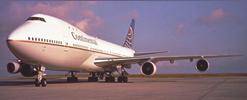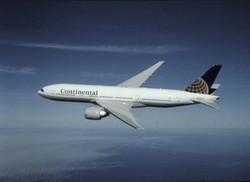It Wasn't Over After September 11
With Continental's huge competitors (United and US Airways, for
example) on creditor-funded and court-ordered life support,
the airline has realized that the industry's overcapacity
problem won't go away. To answer that unintended consequence of
Chapter 11's overuse, Continental -- not in bankruptcy, and wishing
to avoid it -- has announced some painful layoffs.
 The airline has to save half a billion dollars in
operating expenses, in its 2004 plan. With the war and its
uncertainties, the decision to implement heavy cuts had to
be made; and, on Wednesday, it was.
The airline has to save half a billion dollars in
operating expenses, in its 2004 plan. With the war and its
uncertainties, the decision to implement heavy cuts had to
be made; and, on Wednesday, it was.
That afternoon, Continental Airlines announced it will implement
cost-saving measures to improve its current 2004 outlook by $500
million. These measures come as the weak revenue environment and
increased taxes, fuel, security and insurance costs continue to
burden the U.S. airline industry, which has lost $19 billion and
eliminated 100,000 jobs since September 11, 2001.
The 'good news:' no more pay cuts.
 "We need $500 million in annual cost savings and
revenue generation to permit us to be a survivor during the worst
financial crisis in aviation history," said Gordon Bethune (right),
chairman and chief executive officer of Continental. "None of the
savings will come from employee concessions. We are not now asking
for pay cuts. However, if the anticipated war in Iraq is prolonged,
or if other events further degrade revenue or increase costs, we
will need to find additional savings or ways to generate more
revenue in order to compete effectively."
"We need $500 million in annual cost savings and
revenue generation to permit us to be a survivor during the worst
financial crisis in aviation history," said Gordon Bethune (right),
chairman and chief executive officer of Continental. "None of the
savings will come from employee concessions. We are not now asking
for pay cuts. However, if the anticipated war in Iraq is prolonged,
or if other events further degrade revenue or increase costs, we
will need to find additional savings or ways to generate more
revenue in order to compete effectively."
As part of this $500 million initiative, Continental will reduce
its workforce by approximately 1,200 employees by year-end. This
total includes approximately 125 pilots, 500 reservations agents,
350 airport agents and 225 other employees around the system. The
carrier hopes to minimize many of the job cuts through voluntary
exit programs, company-offered leaves of absence and attrition.
These reductions are in addition to the approximately 4,300
employees currently on furlough or company-offered leaves of
absence. The company believes it can avoid further elimination of
flight attendant positions as a result of company-offered leaves of
absence. Likewise, the company's staffing of maintenance workers
has been addressed through a previously-implemented hiring
freeze.
Lots of managers going home, too.
 Shortly after September 11, 2001, Continental
reduced its management and clerical workforce by more than 20
percent. This week, Continental reduced its senior management ranks
by more than 25 percent, and reduced its overall officer group by
more than 15 percent.
Shortly after September 11, 2001, Continental
reduced its management and clerical workforce by more than 20
percent. This week, Continental reduced its senior management ranks
by more than 25 percent, and reduced its overall officer group by
more than 15 percent.
"Five of the top people in our company are leaving this week,"
Bethune said. "It shows we need to look in every nook and cranny to
find every dollar... It is clear to me that other airlines will
fail," he said. "We are not going to be next. [Continental survived
bankruptcy in 1983 and again in 1990 --ed.] There is not going
to be a 'next' for Continental."
Four bigshots retiring March 25:
- Kuniaki "Jun" Tsuruta, senior vice president
purchasing and material services, who joined the airline in April
1994 and was responsible for procurement, global purchasing and
logistics
- Barry Simon, senior vice president
international, and the longest-serving officer at Continental
Airlines
- Bonnie Reitz, senior vice president sales and
distribution, was an original member of the "Worst to First"
turnaround team at Continental. She will continue to do consulting
work for the airline.
- George Mason, senior vice president technical
operations, joined the airline in March 1994 and was responsible
for all facets of technical operations worldwide, including
maintenance, engineering, component repair and overhaul, quality
control and inspection.
The last plan worked.
In August 2002, Continental announced an initiative to
contribute more than $350 million to pre-tax contribution through
revenue generating and cost savings initiatives. The company
exceeded its plan by achieving $400 million on an annual run-rate
basis.
 At the end of February, the company had
approximately $1.2 billion in cash and short-term investments.
At the end of February, the company had
approximately $1.2 billion in cash and short-term investments.
In addition to the 1,200 job cuts, other initiatives
include:
- The elimination by Continental of paper tickets worldwide by
June 30, 2004.
- A significant reduction in distribution expenses, by
implementing a plan to more than double the utilization rate of
continental.com, reduce CRS booking fees and reduce other
distribution costs, by the end of 2004.
- The closing of select city ticket offices.
- The renegotiation of contracts with key suppliers.
- The reduction of airport facility costs and landing fees across
Continental's system.
- Increased use of technology to reduce required staffing
levels.
But wait -- there's more:
Separately, Continental said a protracted war with Iraq or
continued soft demand could lead to further reductions in service,
including to small and medium-sized communities, and further job
eliminations.
 Since September 2001, Continental has ended
service to seven domestic destinations and has announced that
service to two additional small communities would end in May. The
airline reduced its domestic, mainline jet capacity by 6.8 percent
in 2002 compared to 2001, and has grounded more than 20 mainline
aircraft since September 11, 2001, net of new aircraft deliveries.
In addition, Continental Express has grounded 50 turboprop aircraft
since September of 2001.
Since September 2001, Continental has ended
service to seven domestic destinations and has announced that
service to two additional small communities would end in May. The
airline reduced its domestic, mainline jet capacity by 6.8 percent
in 2002 compared to 2001, and has grounded more than 20 mainline
aircraft since September 11, 2001, net of new aircraft deliveries.
In addition, Continental Express has grounded 50 turboprop aircraft
since September of 2001.
Recent schedule reductions
This week, Continental announced temporary schedule reductions
in select international markets, the result of decreased demand
from postponed travel due to concerns of its customers regarding a
potential conflict in the Middle East.
From its New York hub at Newark Liberty International,
Continental will reduce from two daily round trips to one daily
round trip on routes to London/Gatwick and Paris/CDG, and will be
using smaller aircraft on routes to both Amsterdam and Rome. From
Houston/Bush Intercontinental, Continental will reduce from two
daily round trips to one on service to London/Gatwick. These
reductions are planned to be in effect from April 6 through May 1.
Continental will reduce service on the Cleveland-London/Gatwick
route from seven times per week to five times per week for the
period April 15 through May 1. Additionally, daily service from New
York to Tokyo/Narita has been reduced to four times weekly through
April 24.
 ANN's Daily Aero-Linx (04.13.24)
ANN's Daily Aero-Linx (04.13.24) ANN's Daily Aero-Term (04.13.24): Beyond Visual Line Of Sight (BVLOS)
ANN's Daily Aero-Term (04.13.24): Beyond Visual Line Of Sight (BVLOS) Airborne 04.09.24: SnF24!, Piper-DeltaHawk!, Fisher Update, Junkers
Airborne 04.09.24: SnF24!, Piper-DeltaHawk!, Fisher Update, Junkers Aero-News: Quote of the Day (04.14.24)
Aero-News: Quote of the Day (04.14.24) ANN's Daily Aero-Term (04.14.24): Maximum Authorized Altitude
ANN's Daily Aero-Term (04.14.24): Maximum Authorized Altitude







